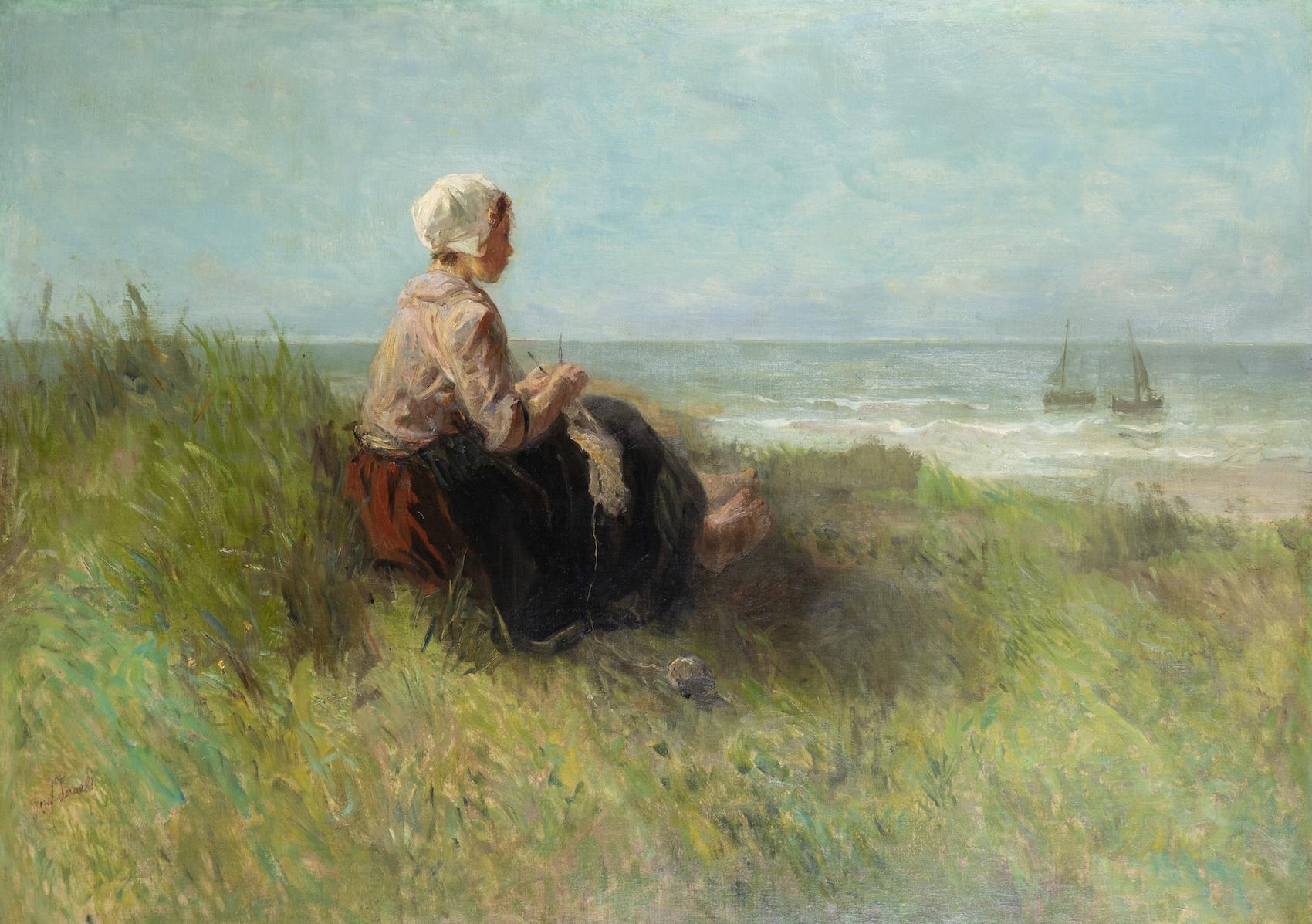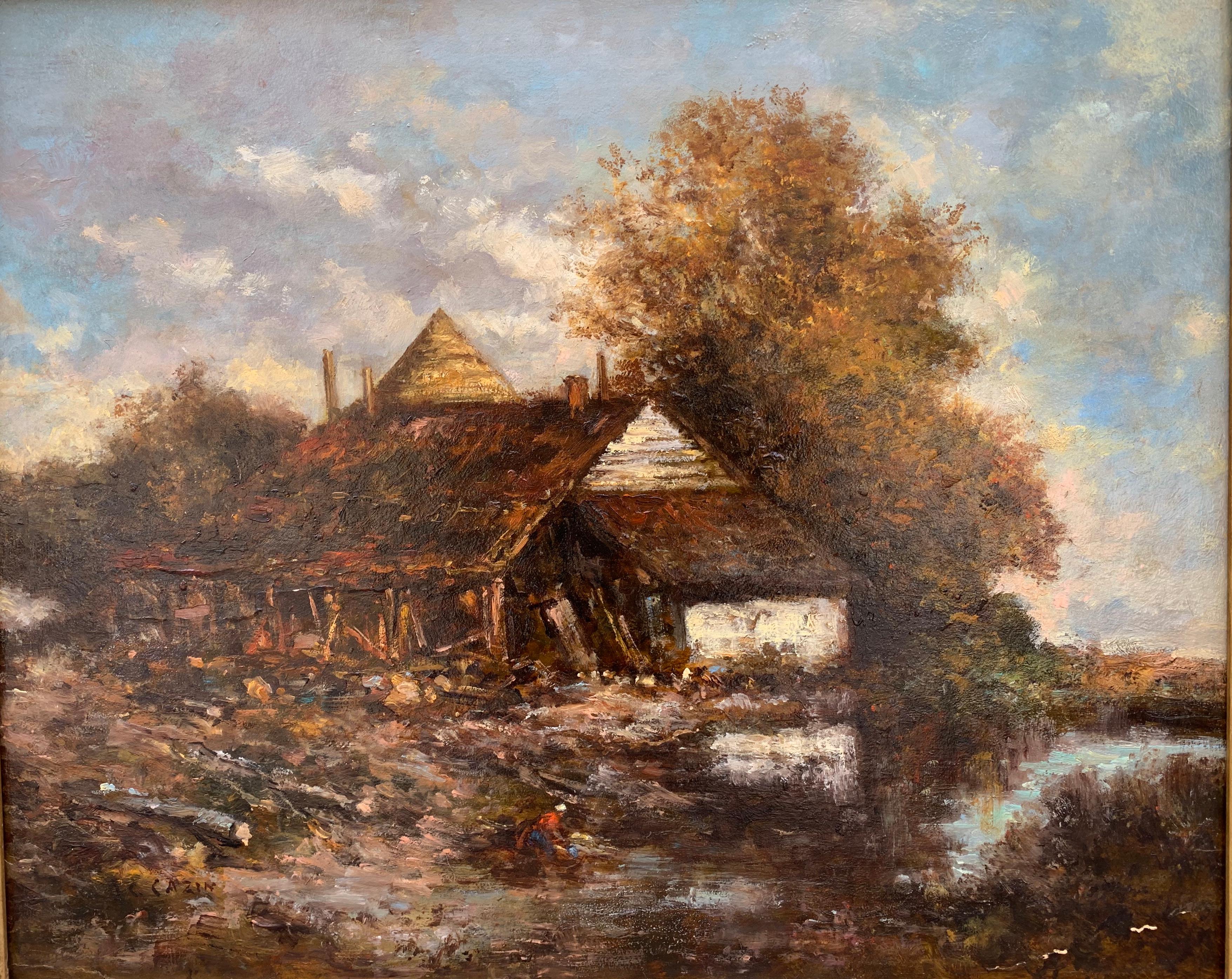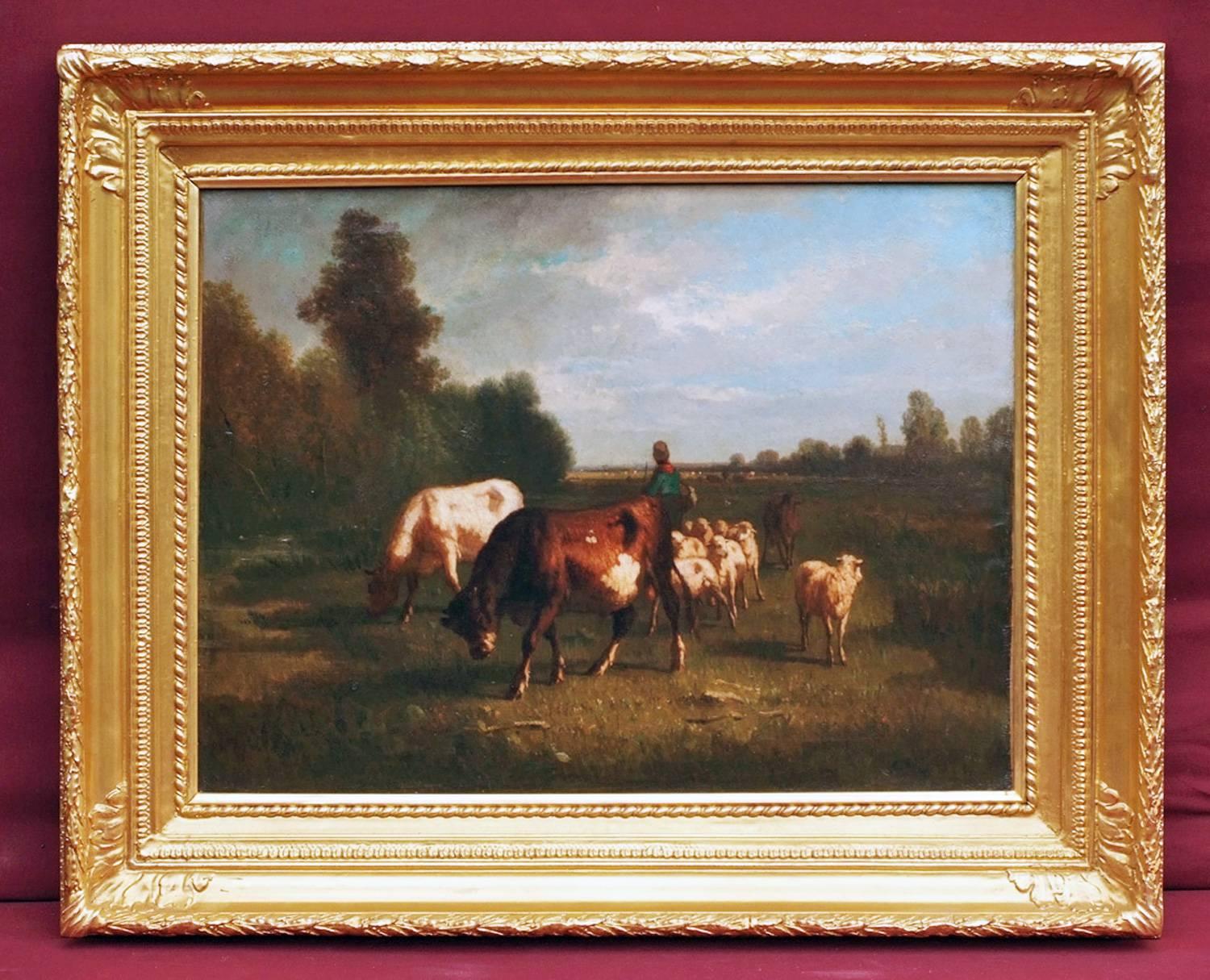Items Similar to French village
Want more images or videos?
Request additional images or videos from the seller
1 of 8
Louis BouchéFrench village1886
1886
About the Item
LOUIS ALEXANDRE BOUCHÉ
Luzancy 1938-1911
French village, 1886
Oil on canvas
33 x 46 cm.
Signed: lower right ‘Louis Bouché’.
Provenance: Barbizon – realist and French landscape paintings, Christie’s New York, 22 May 1997, lot. 275, illustrations p. 125 of the catalogue.
The French landscape painter Louis Alexandre Bouché was, among others, a student of Camille Corot (1796-1875). Many influences of this artist can be seen in Bouché's work. He chose to paint landscapes in the Île-de-France region, near Paris. His works are characterized by the great attention to light and changing atmosphere in subtle colors.
He may have painted a river landscape in 1886 near Lyzancy, showing the river La Marne. After the death of his friend Bouché, his colleague and friend Léon Lhermitte (1844-1925) said he remembered him as: 'the noble artiste, d'ami sûr, d'homme de bien'. The village of Luzancy will remember him as the painter of the landscape of Luzancy, the plowed meadows, and the river Marne with its washerwomen.
- Creator:Louis Bouché (1896-1969, American)
- Creation Year:1886
- Dimensions:Height: 18.12 in (46 cm)Width: 23.04 in (58.5 cm)Depth: 1.78 in (4.5 cm)
- Medium:
- Movement & Style:
- Period:
- Condition:
- Gallery Location:BLARICUM, NL
- Reference Number:1stDibs: LU2625212942062
About the Seller
No Reviews Yet
Vetted Seller
These experienced sellers undergo a comprehensive evaluation by our team of in-house experts.
1stDibs seller since 2023
Typical response time: 4 hours
- ShippingRetrieving quote...Ships From: BLARICUM, Netherlands
- Return PolicyA return for this item may be initiated within 14 days of delivery.
More From This SellerView All
- Soleil couchant à Veere, 1906By Theo van RysselbergheLocated in BLARICUM, NLTheo Van Rysselberghe Gent 1862-1926 Saint-Clair, Var Soleil couchant à Veere, 1906 Ondergaande zon te Veere Oil on canvas 60 x 73 cm. Signed and dated: lower left with monogram ‘0...Category
Early 1900s Impressionist Landscape Paintings
MaterialsOil
- Blossom brancheBy Lodewyk BruckmanLocated in BLARICUM, NLLODEWIJK BRUCKMAN Den Haag 1903-1995 Leeuwarden BLOSSOM BRANCHE, 1946 Oil on canvas 41 x 41 cm. Signed and dated: lower leftCategory
1940s Still-life Paintings
MaterialsOil
- Portrait of a fisherman, VolendamLocated in BLARICUM, NLWILLEM VAN DE BERG Den Haag 1886-1970 Amsterdam Portrait of a fisherman, Volendam 1940 Oil on canvas 70 x 55 cm. Signed and dated: lower left ‘Willem van den Berg...Category
1940s Figurative Paintings
MaterialsOil
- Lavandaie, ca 1905Located in BLARICUM, NLOTTO VAN REES Freiburg im Breisgau 1884-1957 Utrecht WASSENDE VROUWEN I LAVANDAIE 1905 Oil on canvas 43 x 52 cm. Signed: lower left ‘OvR’ Particularities: ID 35. Provenance: Pri...Category
Early 1900s Impressionist Figurative Paintings
MaterialsOil
- Still-life with rosesLocated in BLARICUM, NLADELIN VERLY Brussels 1883-1967 STILL LIFE WITH ROSES Triplex 54 x 54 cm. Signed: lower right 'Adelin Verly' Provenance: Private collection, The NetherlandsCategory
Early 20th Century Dutch School Still-life Paintings
MaterialsOil
- Peinzende vrouwLocated in BLARICUM, NLQUIRIJN VAN TIEL Rotterdam 1900-1967 Rhoon WOMAN ON RIVER 1951 Gouache on paper 41,5 x 59 cm. Signed and dated: lower right ‘Quirijn van Tiel 51’ P...Category
1950s Abstract Expressionist Figurative Drawings and Watercolors
MaterialsGouache
You May Also Like
- Waiting by Jozef Israëls - Landscape oil paintingBy Jozef IsraëlsLocated in London, GBWaiting by Jozef Israëls (1824-1911) Oil on canvas 95.3 x 133.9 cm (37 ½ x 52 ¾ inches) Signed lower left, Jozef Israels A monumental painting by one of...Category
19th Century Barbizon School Figurative Paintings
MaterialsCanvas, Oil
- The Barn, Oil On Bord, Signed Jean-Charles Cazin, Barbizon School, 1865By Jean-Charles CazinLocated in Paris, FROil on panel representing a barn, signed JC Cazin on the lower left corner. Jean Charles Cazin (1840-1901) Born in Samer (his father, from Bologna,...Category
Late 19th Century Barbizon School Landscape Paintings
MaterialsOil
- Oil Painting 19th Century Cows Landscape BarbizonBy Antonio CortesLocated in Saint-Ouen, FRCORTES Antonio (1827-1908) Cows to pasture Oil on canvas signed lower left Old frame gilded with leaves Dim canvas : 54 X 65 cm Dim frame: 70 x 86 cm...Category
1860s Barbizon School Animal Paintings
MaterialsOil
- Barbizon School Lakeside Landscape With CastleLocated in Cotignac, FRAn oil on panel idyllic landscape by Boggio. The painting is signed bottom right. An idealised lakeside landscape view with a castle in the distance in the style of the Barbizon sch...Category
Mid-20th Century Barbizon School Landscape Paintings
MaterialsOil, Board
- Barbizon School Lakeside Landscape, The Shady Glen.Located in Cotignac, FRAn oil on panel idyllic landscape by Boggio. The painting is signed bottom right. An idealised lakeside landscape view of a shady glen in the style of the Barbizon school.Category
Mid-20th Century Barbizon School Landscape Paintings
MaterialsOil, Board
- The Forest, Large Barbizon School, Oil on Canvas Wooded LandscapeBy Emile Roux-FabreLocated in Cotignac, FRA French Barbizon School oil on canvas forest view by Emile Roux-Fabre. The painting is signed and dated bottom left with a dedication. A charming view of forest glade leading out to a valley landscape beyond. The artist has captured the magic feeling of the cool forest shade against the sunshine of the landscape beyond. The texture of the bark on the silver birch trees, the contrast of the leaves on the trees all framing the perspective to the view beyond. An extremely accomplished and atmospheric painting. The Barbizon school of painters was part of an art movement towards Realism in art, which arose in the context of the dominant Romantic Movement of the time. The Barbizon school was active roughly from 1830 through 1870. It takes its name from the village of Barbizon, France, on the edge of the Forest of Fontainebleau, where many of the artists gathered. Most of their works were landscape paintings, but several of them also painted landscapes with farmworkers, and genre scenes of village life. Some of the most prominent features of this school are its tonal qualities, colour, loose brushwork, and softness of form. The leaders of the Barbizon school were: Théodore Rousseau, Charles-François Daubigny, Jules Dupré, Constant Troyon, Charles Jacque, and Narcisse Virgilio Díaz. Jean-François Millet lived in Barbizon from 1849, but his interest in figures with a landscape backdrop sets him rather apart from the others. Jean-Baptiste-Camille Corot was the earliest on the scene, first painting in the forest in 1829, but his work has a poetic and literary quality which sets him somewhat apart. Other artists associated with the school, often pupils of the main group, include: Henri Harpignies, Albert Charpin, François-Louis Français and Émile van Marcke. In 1824 the Salon de Paris exhibited works of John Constable, an English painter. His rural scenes influenced some of the younger artists of the time, moving them to abandon formalism and to draw inspiration directly from nature. Natural scenes became the subjects of their paintings rather than mere backdrops to dramatic events. During the Revolutions of 1848 artists gathered at Barbizon to follow Constable's ideas, making nature the subject of their paintings. The French landscape became a major theme of the Barbizon painters. Millet extended the idea from landscape to figures — peasant figures, scenes of peasant life, and work in the fields. In The Gleaners (1857), for example, Millet portrays three peasant women working at the harvest. Gleaners are poor people who are permitted to gather the remains after the owners of the field complete the main harvest. The owners (portrayed as wealthy) and their laborers are seen in the back of the painting. Millet shifted the focus and the subject matter from the rich and prominent to those at the bottom of the social ladders. To emphasize their anonymity and marginalized position, he hid their faces. The women's bowed bodies represent their everyday hard work. In the spring of 1829, Jean-Baptiste-Camille Corot came to Barbizon to paint in the Forest of Fontainebleau, he had first painted in the forest at Chailly in 1822. He returned to Barbizon in the autumn of 1830 and in the summer of 1831, where he made drawings and oil studies, from which he made a painting intended for the Salon of 1830; "View of the Forest of Fontainebleau'" (now in the National Gallery in Washington) and, for the salon of 1831, another "View of the Forest of Fontainebleau"'. While there he met the members of the Barbizon school: Théodore Rousseau, Paul Huet, Constant Troyon, Jean-François Millet, and the young Charles-François Daubigny. During the late 1860s, the Barbizon painters attracted the attention of a younger generation of French artists studying in Paris. Several of those artists visited Fontainebleau Forest to paint the landscape, including Claude Monet, Pierre-Auguste Renoir, Alfred Sisley and Frédéric Bazille. In the 1870s those artists, among others, developed the art movement called Impressionism and practiced 'plein air' painting. In contrast, the main members of the school made drawings and sketches on the spot, but painted back in their studios. The Post-Impressionist painter Vincent Van Gogh studied and copied several of the Barbizon painters as well, including 21 copies of paintings by Millet. He copied Millet more than any other artist. He also did three paintings in Daubigny's Garden. The Barbizon painters also had a profound impact on landscape painting in the United States. This included the development of the American Barbizon school by William Morris Hunt. Several artists who were also in, or contemporary to, the Hudson River School studied Barbizon paintings for their loose brushwork and emotional impact. A notable example is George Inness, who sought to emulate the works of Rousseau. Paintings from the Barbizon school also influenced landscape painting in California. The artist Percy Gray...Category
Early 20th Century Barbizon School Landscape Paintings
MaterialsCanvas, Oil
Recently Viewed
View AllMore Ways To Browse
Antique Villages
The Antique Village
French Village Oil Painting
River Landscape Village
Ile De France
French Barbizon
Landscape French Village Oil On Canvas
Barbizon Frame
French Barbizon Painting
Barbizon Artists
French Homme
19th Century Oil Paintings Of A Village
French Barbizon Oil Painting
Barbizon School French Landscape Paintings
Used Plows
French Noble Painting
19th Century French Barbizon Landscape Painting
Camille Corot





